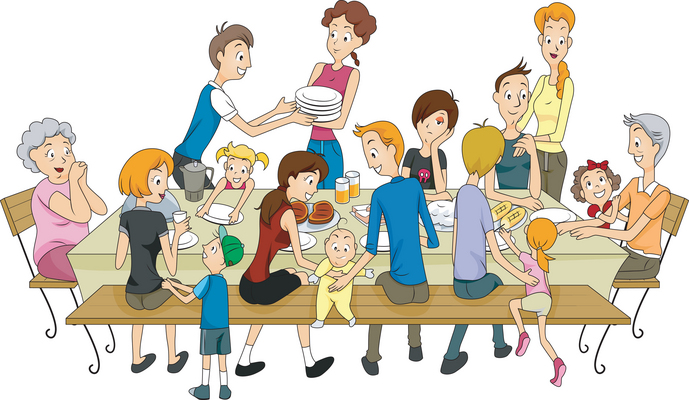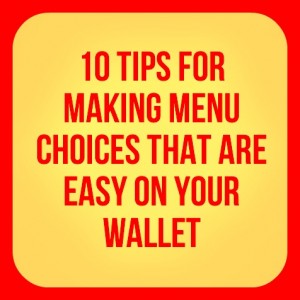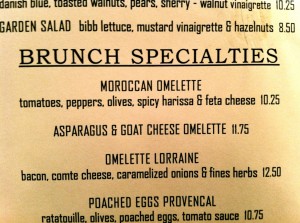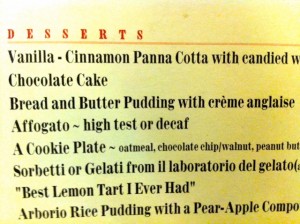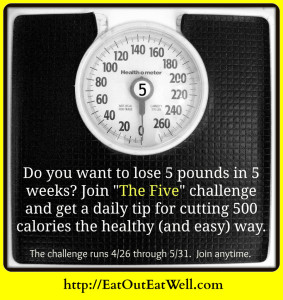
Did you wake up this morning feeling like an extra five pounds of fat attached itself to your body — and you have no idea how it got there? Maybe there’s only four pounds if you challenged yourself to eating a bit differently and moving a bit more during Week #1.
Take “The Five” Challenge and safely lose a pound a week the easy and healthy way – and in a manner that will help you to keep the weight off.
Why Five?
We take in energy through food (calories in) and expend energy through our bodies’ metabolic processes and through activity (calories out).
About 3500 calories equals one pound of body weight so you’d have to eat around 3500 calories less than your body needs to lose one pound. Since we’re all unique, each one of us gains, loses, and processes calories at our own unique rate.
Even with our unique variations, choosing 3500 calories as a weekly target when you’re trying to lose weight is reasonable and doable. Taking in 500 calories a day less than your body needs and/or using up more calories through activity will help you to lose approximately one pound in a week (7 days x 500 calories = 3500 calories or approximately one pound). Do this for 5 weeks and you will have lost around 5 pounds.
Remember – that’s 500 FEWER calories and/or MORE activity than what you normally would eat or do.
“The Five” Challenge In A Nutshell
It’s as simple as this:
- decrease your energy intake by 500 calories a day
or
- expend 500 calories a day more than you usually do
or
- use any combination of the two that adds up to 500 – for instance, eat 250 calories less and move around for 250 calories more than you usually do – or you could eat 350 calories less and burn 150 calories through activity.
Do this seven days a week for five weeks and you should be around five pounds lighter. Everyone is different – we all calculate calories and activity differently and everyone loses weight at a different rate. But, if you hop on the challenge you certainly will see some results and you’ll be building great new habits.
The Specifics
- Every day I’ll post a calorie saving tip on EatOutEatWell.com that focuses on eating behaviors, food selection, or ways to burn calories through activity. I’ll also tweet and post the tip on Facebook, and Pinterest.
- Everyone eats out — whether it’s for a snack or a meal — I want to encourage you to Eat Out and Eat Well. Many of the tips are geared toward helping you when you eat in restaurants, amusement parks, ballparks, barbecues, airports, at parties, on vacations, or at work.
- When deciding which tip(s) to use, choose the ones you think will work for you and that will fit into your daily life without much difficulty or stress.
- Do one thing for seven days, or for all 35 days (great for habit formation), or try something new everyday. The choice is yours, but take a chance and do something. Those “a little too tight” clothes in your closet will fit much better.
- Post what you choose to do on Facebook. Also post if you’re struggling. There’s a community out there to help.
Week #1:
Tip #1: What’s your coffee (or tea) pleasure? How many cups do you drink and are they small, tall, grande, vente or extra large? What else do you put in the cup along with the coffee or tea?
Here’s some facts – use them to decide how to moderate your coffee/tea calories. The calories below are for 1 tablespoon. My guess is that most of us pour at least two to three tablespoons of milk or cream into our coffee, not just one. Add up the calories and multiply them by the number of cups of coffee or tea you have a day. It’s not at all far fetched to be drinking 500 calories of coffee or tea when it’s made with extras.
- Brewed coffee, grande (16 oz), black: 5 calories
- Brewed tea, (16 oz): 4 calories
- Heavy cream, 1tbs: 52 calories
- Half-and-half, 1 tbs: 20 calories
- Whole milk, 1 tbs: 9 calories
- Fat-free milk, 1 tbs: 5 calories
- Table sugar, 1tbs: 49 calories
- Bailey’s Irish Cream, 1.3 ounces: 121 calories
Remember to post on Facebook and to share the challenge with family, friends, and coworkers.
